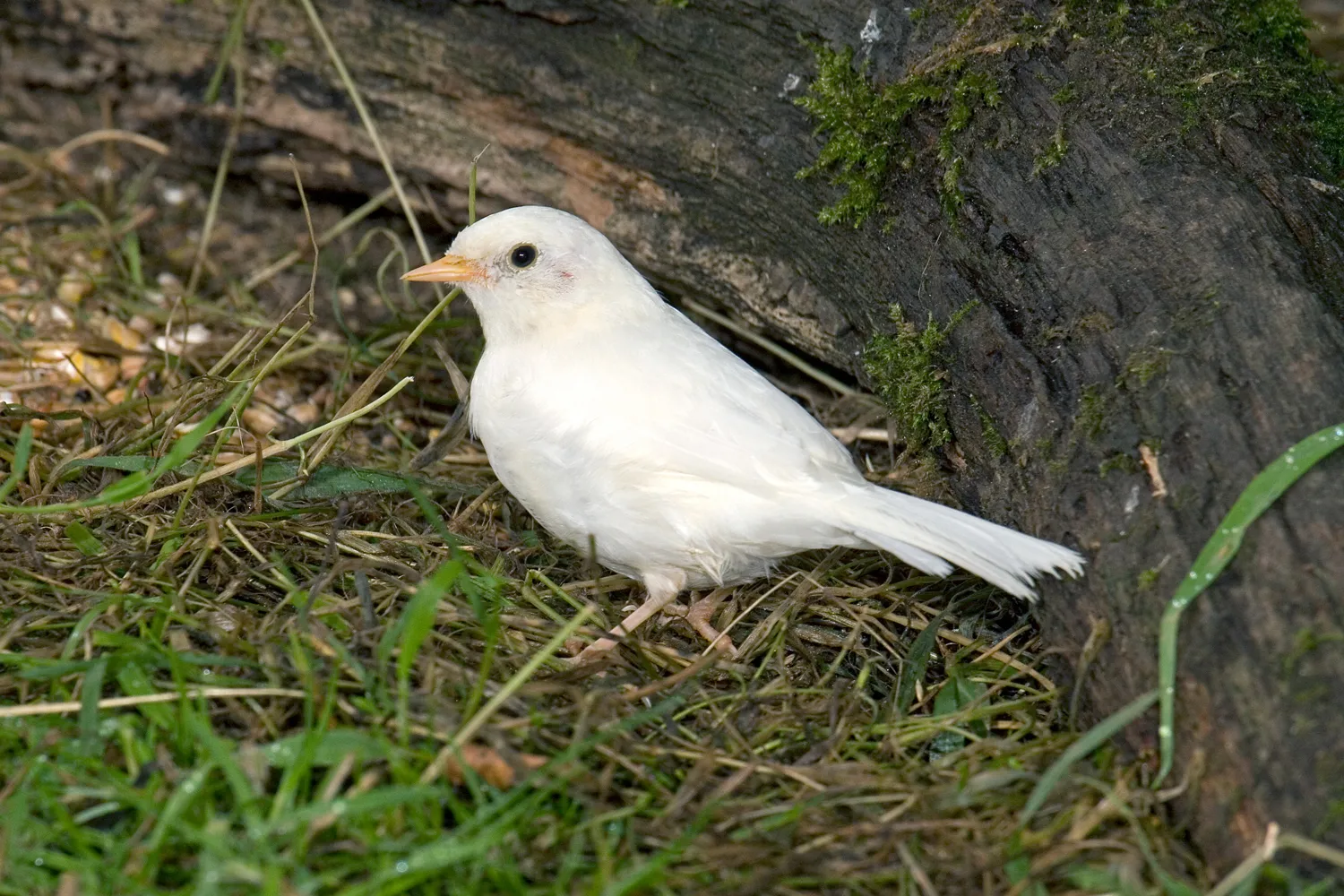From time to time, you may encounter a bird with plumage that is rather different from that which would be typical for the species. Some of these abnormalities may result from abnormal feather growth or feather loss, while others may be a consequence of problems with pigmentation.
Plumage differences caused by pigmentation changes
Changes in the amount and/or distribution of particular feather pigments are some of the most commonly reported types of plumage abnormality. Most often, these abnormalities occur within the common feather pigments, such as melanin (which makes feathers look dark), and so we tend to see a pattern to the types of abnormalities being reported.
Through our Abnormal Plumage Survey, we know that the most frequently reported plumage irregularities are when birds gain odd white feathers. Interpreting exactly what condition these birds have can be tricky, however.
Leucism
Leucism is an inherited absence of pigment cells, and can be total (causing whiteness of the whole plumage) or partial (causing whiteness in just parts). The white pattern is present throughout a bird’s life and does not change with age. Over three-quarters of the sightings reported through the BTO Abnormal Plumage Survey have been categorised as ‘leucistic’, with Blackbirds and House Sparrows most frequently spotted.
We have used the term ‘leucism’ to describe plumage abnormalities where feathers become paler or turn white unexpectedly, but where eyes retain their normal dark colour. The latter feature has been used to distinguish leucistic birds from albinistic ones, which have red or pink eyes, owing to blood being visible through colourless tissue. While these broad categorisations have proved useful when recording birds at distance in gardens, there are subtleties to discover.
Albinism
A common misnomer for a bird with a few white feathers is ‘partial albino’. This is a contradiction in terms; an individual is either albino or it is not. Albinism is characterised by a total lack of melanin pigments (i.e. black, grey and brown) due to an inherited absence of an enzyme that catalyses melanin production. Albino individuals are totally white unless carotenoid pigments (i.e. pale yellow to scarlet red) are also present. An albino adult Goldfinch, for example, would be white all over, except for its red face and gold wing bars.
Ino
Seeing an adult albino in the wild is very unlikely, since bad eyesight (one of the consequences of albinism) means that survival prospects are poor. It is also worth noting that an apparently albino bird might be confused with an ‘ino’ individual. In an ino individual melanin is still produced but it loses its dark qualities. An ino can appear white all over and has reddish eyes, but its eyesight is much better than an albino’s and so an adult bird matching this description is almost certainly an ino not an albino.
Understanding leucism
Although we use the term ‘leucism’, in reality it covers a number of distinct types of abnormality. While leucism, from the Greek Leukos, means ‘white’, amongst birdwatchers the definition has drifted from white feathers to include pale, washed-out colouration. The latter, however, is caused by other heritable aberrations, of which ‘Brown’ and ’Diluted’ are the most common. In 'Brown', changes in the appearance of melanin pigments cause black feathers to turn brown. These, in turn, are easily bleached by sunlight, causing them to turn whitish. Dilution, whereby reduced melanin production causes individuals to appear washed out, might also cause confusion.

A leucistic Dunnock, by John Harding / BTO
Progressive greying
Far more common than leucism is 'Progressive Greying', which is acquired rather than inherited. Progressive greying sees the progressive loss or failure of pigment cells with age, although this can also be caused by physical disorders. From the onset of the condition, the bird will gain increasing numbers of white feathers after every moult. Should the bird live long enough, it will eventually be all-white. Progressive greying is particularly common in Blackbirds, House Sparrows and Jackdaws but is difficult to distinguish from leucism without knowing the history of the individual.
Other types of pigmentation changes
Other types of abnormal plumage result from other forms of pigmentation change. In addition to albinism and leucism, there are:
Melanism
Melanism is generally defined as a condition where there is an increased amount of dark (melanin) pigmentation (melanin). However, research has shown that melanism can also result in a paler than normal plumage, and that aberrant dark plumage is not necessarily the result of increased amounts of pigment.
Erythrism
Erythrism is a condition where a chestnut-red pigment replaces certain other pigments, leading to a more rufous or reddish appearance to the plumage. It may be result from a genetic mutation or have a dietary basis.
Xanthochromism
Xanthochromism is a condition where there is an excess of yellow pigment (often replacing red pigment). It may be result from a genetic mutation or have a dietary basis.
Disadvantages
Having plumage that differs from the population 'norm' is often disadvantageous, giving the wrong signals to other individuals or making the bird more obvious to would-be predators. Feathers with reduced pigment are often less robust and wear more rapidly, reducing flight efficiency and decreasing their insulative properties.
Report unusual plumage
If you have seen a bird with unusual plumage in your garden please report it by completing our simple online Abnormal Plumage Survey record form.